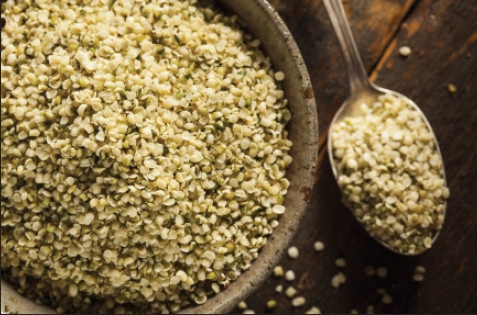Who knew a bunch of plants could be such big business? According to a report by Amadee + Company, sales of plant-based omega-3s are set to grow twice as fast as their fish and marine counterparts over the next several years (1). This means that plant sources are staking an increasing claim within the multi-billion dollar omega-3 industry.
To take advantage of this opportunity, it will help to understand the primary consumers of plant-based omegas, and how these foods and dietary supplements can be promoted effectively.
Who Buys Plants and Why
Plant-based omega sources, like flax, chia, algae, hemp and others, possess a broad consumer appeal. Laura King, marketing manager for DSM Nutritional Products, Parsippany, NJ, says sales come from all channels, from natural to mass market and online. Consumers in this category also span all age groups, from infants to baby boomers.
Vegetarians and vegans take a special interest in plant-based options, King says, a notion confirmed by many others in the industry. Several other groups also tend to look for plant-based options, such as pregnant and nursing women, she adds.
Much of the positive feedback received by  Trisha Sugarek MacDonald, B.S., M.S., director of R&D and national educator for Bluebonnet Nutrition Corporation, Sugar Land, TX, comes from pregnant women taking her company’s vegetarian omega-3 DHA product. “These women are mostly trying to get the additional DHA into their diet since their doctors limit the amount of fish they can consume due to a risk of heavy metal contamination,” she says. Some women, she explains, are dealing with pregnancy symptoms, and don’t wish to potentially add to their digestive issues through regular fish oil consumption. They appreciate the plant-based product’s lack of smell, reduced regurgitation effects and easier digestion, Sugarek MacDonald says.
Trisha Sugarek MacDonald, B.S., M.S., director of R&D and national educator for Bluebonnet Nutrition Corporation, Sugar Land, TX, comes from pregnant women taking her company’s vegetarian omega-3 DHA product. “These women are mostly trying to get the additional DHA into their diet since their doctors limit the amount of fish they can consume due to a risk of heavy metal contamination,” she says. Some women, she explains, are dealing with pregnancy symptoms, and don’t wish to potentially add to their digestive issues through regular fish oil consumption. They appreciate the plant-based product’s lack of smell, reduced regurgitation effects and easier digestion, Sugarek MacDonald says.
Alberto Trujillo, national educator for Flora, Inc., Lynden, WA, says the primary consumer in this category remains the educated, middle- to upper-class mother. Then, he adds, there are the fitness and health enthusiasts, who possess a better-than-average knowledge of what their bodies need. Elite athletes, especially, are looking to stay on the cutting edge of human performance, and understand the relevance of plant-based omegas for energy, stamina and recovery, Trujillo says.
The past several years have brought Trujillo’s company specific feedback from athletes. He explains that endurance athletes like marathoners and cyclists are now turning to plant oils and blends. Plant-based omega blends are sometimes recommended by Web sites that these athletes frequent. “The feedback we are getting is that the oils help in recovering faster from hard workouts and races. They are able to sustain higher volumes of training, and run longer and stronger than before using the oils,” Trujillo says.
Though vegans and vegetarians are seeking out non-animal sourced nutrition for obvious reasons, many people simply do not like to consume fish, and these represent another group of plant-based buyers, says Dean Mosca, president of Proprietary Nutritionals Inc., Kearny, NJ. They may still associate marine-sourced omegas with a certain “oceanic” aftertaste.
 Andreas Koch, marketing director for Barlean’s, Ferndale, WA, says there is no way to pigeonhole his company’s consumers in this category. “We’ve found customers using flaxseed and flaxseed oil for a variety of reasons,” he says. Beyond the vegan/vegetarian attraction, the “price per bottle” of plant-based omegas compared with fish oil is one factor drawing people in, Koch says. Concerns about the sustainability of fish oil also drive some consumers to plant options. In addition, the more limited processing needed for plant sources when compared with marine sources is something some people value. Consumers also choose plant sources because of the many ways they can be used as food. Koch notes that options like flax can be used in countless recipes, and that flax specifically has a nutty flavor that mixes well in many dishes.
Andreas Koch, marketing director for Barlean’s, Ferndale, WA, says there is no way to pigeonhole his company’s consumers in this category. “We’ve found customers using flaxseed and flaxseed oil for a variety of reasons,” he says. Beyond the vegan/vegetarian attraction, the “price per bottle” of plant-based omegas compared with fish oil is one factor drawing people in, Koch says. Concerns about the sustainability of fish oil also drive some consumers to plant options. In addition, the more limited processing needed for plant sources when compared with marine sources is something some people value. Consumers also choose plant sources because of the many ways they can be used as food. Koch notes that options like flax can be used in countless recipes, and that flax specifically has a nutty flavor that mixes well in many dishes.
A similar phenomenon is taking place with hemp. “We are seeing a steady increase in hemp products because of their taste. Hemp foods have a slightly nutty taste, which compliments pretty much anything,” says Mike Fata, CEO and cofounder of Manitoba Harvest, Winnipeg, MB, Canada. No matter how healthy something is for you, he adds, people won’t continue to consume it if the taste is not satisfactory.
A broader reason for increased interest in plant options is the fact that omega-3s are now more fully appreciated as nutrients. Specific dietary recommendations and guidelines for omega-3 intakes are now appearing, explains Sugarek MacDonald.
In a Scientific Statement, the American Heart Association suggested Americans should consume at least two servings of fish per week, and include omega-rich vegetable oils in their diet, according to Sugarek MacDonald. Specifically, they recommended oils high in alpha linolenic acid (ALA), an essential fatty acid found primarily in plants.
Consumer awareness of such recommendations, combined with the fact that many are allergic to fish or are vegetarian, means more are being drawn to plant options. The general trend of consumers moving away from animal-based products, Sugarek MacDonald argues, bodes well for plant options. “It is quite possible that plant-based omega-3 fatty acids will be the ‘go-to’ omega-3s in future years,” she says.
Consumers have numerous options from which 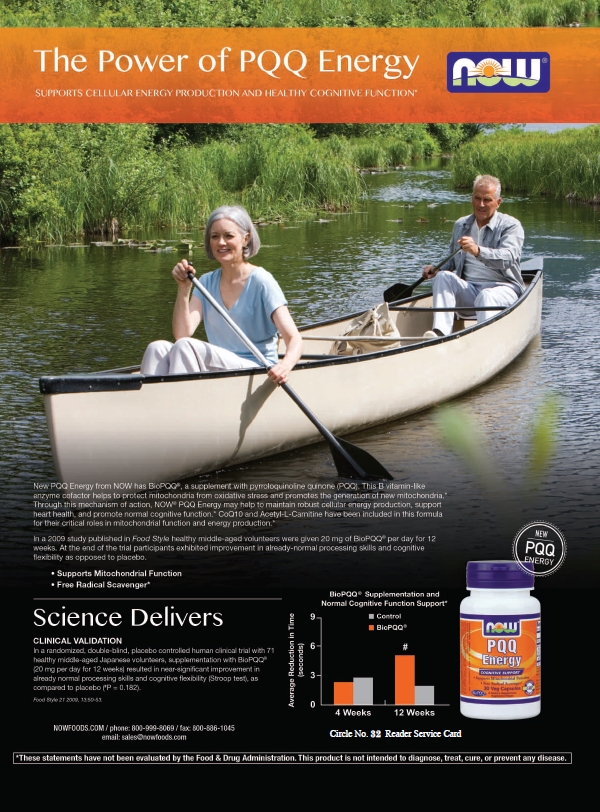 to choose right now. Susan Hazels Mitmesser, Ph.D., director of nutrition research at Solgar, Leonia, NJ, describes several beyond flaxseed oil, which is known for its ALA content. “Borage and evening primrose oils provide omega-6 gamma-linolenic acid (GLA), a fatty acid that helps regulate a variety of important cellular and metabolic functions in the body,” she says, adding that safflower oil contains an abundance of an essential omega-6 fatty acid called linoleic acid (LA).
to choose right now. Susan Hazels Mitmesser, Ph.D., director of nutrition research at Solgar, Leonia, NJ, describes several beyond flaxseed oil, which is known for its ALA content. “Borage and evening primrose oils provide omega-6 gamma-linolenic acid (GLA), a fatty acid that helps regulate a variety of important cellular and metabolic functions in the body,” she says, adding that safflower oil contains an abundance of an essential omega-6 fatty acid called linoleic acid (LA).
The traditional marketing of plant-based omegas to vegans and vegetarians may shift as certain misconceptions are cleared up, according to Alexandra Charles, director of education for Essential Formulas Inc., Irving, TX. For one, the nutritional importance of omega-3 ALA has often been understated, and it has been positioned as a lesser counterpart to the forms usually associated with marine sources, EPA and DHA. Charles emphasizes that ALA is classified as “essential” because it cannot be synthesized by the body, as EPA and DHA can. ALA is also responsible for a number of health benefits on its own. “As people are realizing the merit of ALL forms of omega-3s, the market is expanding,” she says. More on this process of updating conventional wisdom on fatty acids will come later.
All in all, people are purchasing plant-based omegas for the same core reasons they purchase fish and marine oils, according to King: the brain, heart, eye and other health benefits associated with their intake. Koch says that in addition to omega-3 content, people also turn to options like flax and chia seed because of their other nutrients, including fiber, lignans, vitamins, minerals and amino acids.
Rally Ralston, managing partner of Salba Smart Natural Products, LLC, Centennial, CO, shares a similar perspective. He says feedback on his company’s proprietary chia shows that consumers know it is a good source of omega-3s, protein and fiber, along with other nutrients.
A Growing Plant-Based Market?
The consumer interest in these products is ripe to be leveraged into sales and repeat purchases by retailers. To accomplish this, Fata suggests cross-promotions that show how versatile plant-based omega products can be. Straightforward signage that calls out the nutritional bona fides of plant-based omegas can also be effective, he says.
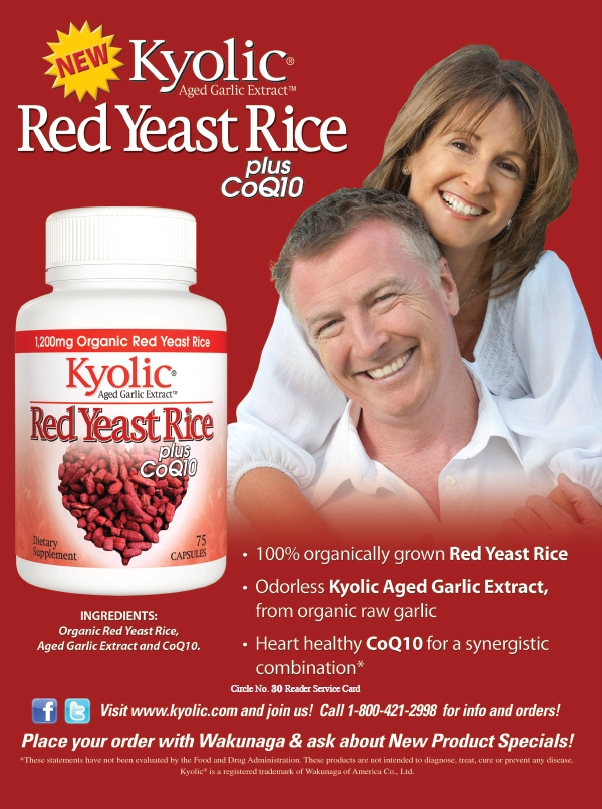 Some purchases in this category may come about through sheer curiosity, and retailers can plan for this, too. “Shelf placement and in-store promotions play a huge role in purchasing behavior,” Fata says. Supplements in this category are often found in the cooler or supplement sections of stores, so consumers don’t usually find them by chance, he explains. But an end-cap of plant-based foods may lead to impulse purchases for those not as familiar with the concept of plant-based omegas.
Some purchases in this category may come about through sheer curiosity, and retailers can plan for this, too. “Shelf placement and in-store promotions play a huge role in purchasing behavior,” Fata says. Supplements in this category are often found in the cooler or supplement sections of stores, so consumers don’t usually find them by chance, he explains. But an end-cap of plant-based foods may lead to impulse purchases for those not as familiar with the concept of plant-based omegas.
Banking on creating consumer interest through pretty packaging or a novel concept (which is what plant-based omegas still represent to many people) may seem like a superficial solution. But, Charles says that this approach doesn’t necessarily limit the category, and may actually help to expand it. This is because, she says, “regardless of why people are drawn to products in the category, once they purchase them and realize the benefits of plant-based omegas, another repeat consumer has been created.”
Trujillo, however, does not believe purchases are going to happen randomly in this category. “I think consumers would have to have heard or briefly read about flax or other types of healthy oils containing omegas, and when they see the words on a product it spikes interest,” he says.
Retailers simply need to commit to education, Trujillo says, to reap the benefits in this category, but he laments that many seem to be pulling back from educational efforts to due lack of funds to train staff. “Those retailers that continue to value education will benefit because an educated staff can better serve the needs of their customers,” he says.
For this market to truly grow unencumbered, both consumers and retailers will need to become more educated about fatty acids, Trujillo believes. He argues that many have been misled that “micronutrient” fatty acids like EPA and DHA are a simple solution to health problems. They are indeed important, he says, but are not enough to overcome the health issues that stem from consistently unhealthy dietary fat intake. The reason is that they represent too small a fraction of the average individual’s fat consumption. For example, someone consuming an average of 100 g of dietary fat per day may be taking 1 g (1,000 mg) of EPA and DHA. People have been told that these specific omegas will diminish their disease risks, but he feels this sometimes falsely implies that the quality of the rest of one’s fat intake does not matter.
Trujillo suggests that making major changes to fat intake by 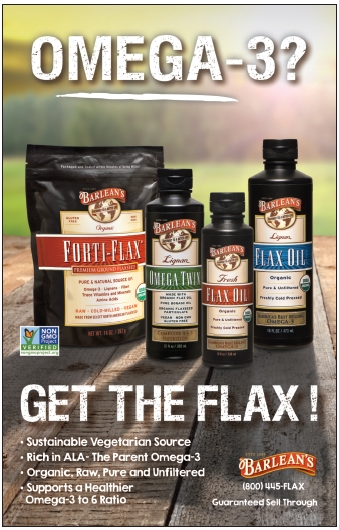 ingesting larger amounts of primarily plant-based fatty acids is the way to go. “This is why the derivative fatty acids (EPA, DHA and GLA) are considered micronutrients and the plant-based essential fatty acids (ALA and LA) are macronutrients,” he says. Higher amounts of these healthy omegas will begin to displace the bad fats in the diet, and many of the health benefits associated with omegas will start to become evident over time, he explains.
ingesting larger amounts of primarily plant-based fatty acids is the way to go. “This is why the derivative fatty acids (EPA, DHA and GLA) are considered micronutrients and the plant-based essential fatty acids (ALA and LA) are macronutrients,” he says. Higher amounts of these healthy omegas will begin to displace the bad fats in the diet, and many of the health benefits associated with omegas will start to become evident over time, he explains.
The best results will come through the intake of both the essential fatty acids and their derivatives, Trujillo says, so we must overcome the perception that one is better than the other. He praises organizations that have done so much to spread the word about the likes of EPA and DHA, but says that the message should not be taken further to imply that plant-based omegas aren’t worthwhile. He says that animal-sourced omegas provide virtually no omega-3 ALA or omega-6 LA, which, strictly speaking, are the only essential fatty acids.
Also noteworthy is that sustainable plant-based EPA and DHA sources have emerged recently, and consumers will soon realize they can find products with more complete omega profiles, Trujillo feels. The addition of EPA, DHA and GLA to plant-based products has made irrelevant the notion that some people can’t convert enough essential fatty acids, he says. He predicts that 10 or 20 years from now, many EPA and DHA supplements will come from plant-based sources like algae.
Hazels Mitmesser says that algae continues to evolve as a source of omegas. Many different species of algae produce omegas, she says, and by growing them under controlled conditions and harvesting omegas directly from them, purity can be maintained and ocean resources can be preserved.
In the flaxseed category specifically, Koch says that sales have been steady, without any major spikes or dips. He stresses the importance of informing consumers that the body can indeed convert sufficient amounts of ALA into EPA and DHA to make plant sources worthwhile choices. Driving home this concept to omega-3 shoppers will help grow sales, he says.
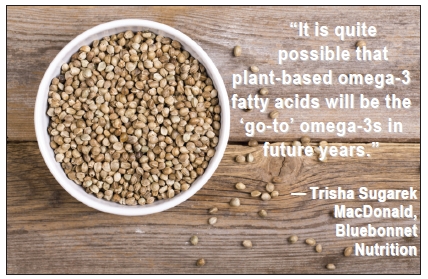 Mosca reports that the growth of the chia market is strong in part due to its versatility, and it can now be found in many packaged food products. Both chia and flax are associated with good health in consumers’ minds, he says. If a new cracker, for example, is launched with chia as an ingredient, as long as it is price appropriately and retailers sample the product, purchases should increase. “People love to eat and food manufacturers know this. And when the ever-growing number of health-minded consumers eat something they perceive is health-promoting, they feel good about what they buy for themselves and their families,” Mosca says.
Mosca reports that the growth of the chia market is strong in part due to its versatility, and it can now be found in many packaged food products. Both chia and flax are associated with good health in consumers’ minds, he says. If a new cracker, for example, is launched with chia as an ingredient, as long as it is price appropriately and retailers sample the product, purchases should increase. “People love to eat and food manufacturers know this. And when the ever-growing number of health-minded consumers eat something they perceive is health-promoting, they feel good about what they buy for themselves and their families,” Mosca says.
The plant-based market is growing in step with the omega-3 market. According to research cited by Sugarek MacDonald, omega-3 products are worth over $4.5 billion at the producer level and almost $32 billion in retail sales, and the market is set to grow more than 15% annually until at least 2018 (1). Therefore, she says that the plant-based sub-sector will only be getting bigger in the near future.
Another projection has the global market for omega-3 products reaching $7.32 billion by 2020, according to Ralston (2).
Food vs. supplements. Though plant-based foods rich in omegas may not seem to occupy the same territory that plant-based omega oils and supplements do, Koch sees common ground. When consumers go to the store to buy each, they are striving to bring more omega-3s into their diet, he says. Supplement users may be seeking the convenience of a quick softgel or tablespoon of oil, while food shoppers may be looking to complete a recipe. The same shopper, he adds, may switch from one to the other at any time.
|
Genetically Modified Omegas? It seems no sector of the food and nutrition industry will be exempt from the great genetically modified organisms (GMOs) experiment. Recent reports indicate that field trials are taking place in England on plants, specifically camelina flax (Camelina sativa), that have been genetically engineered to produce long chain omega-3 fatty acids. This species has had seven genes from algae spliced into its own native genes, and the result is that they produce high levels of EPA and DHA. When grown in a greenhouse, the species has produced seeds with an average of nearly 20% EPA and DHA content. One possible reaction to this development is outright rejection, and this will likely be the stance of many natural and organic shoppers if this technology ever went mainstream. “There are already so many non-GMO options (both in the mainstream and the natural sector). I really hope the market rejects artificially induced omega products,” says Mike Fata, CEO and cofounder of Manitoba Harvest, Winnipeg, Manitoba. Andreas Koch, marketing director for Barlean’s, Ferndale, WA, says there will always be shoppers willing to pay slightly more for organic, non-GMO products. There will also always be many price-conscious shoppers that may adopt an omega-3 source like this without any problem. “I believe conscientious organic and/or natural food consumers will be very conflicted about this topic,” says Trisha Sugarek MacDonald, B.S., M.S., director of R&D and national educator for Bluebonnet Nutrition Corporation, Sugar Land, TX. She acknowledges the consensus that dietary omega-3 intakes need to be increased in much of the population. The problem of how remains largely unsolved, especially for those who for whatever reasons cannot eat fish. The concept of enriching foods with omega-3s is very logical, but most existing sources (natural vegetable and nut oils, marine oils and algal oils) have their limitations, she says. There are also questions about the sustainability of global fisheries and the safety of fish oil, making the GMO route a vexing question. These ingredients are not necessary in the opinion of Alberto Trujillo, national educator for Flora, Inc., Lynden, WA. Algae already efficiently produces DHA and EPA without the use of GMOs. If industries are allowed to leave consumers uninformed about the presence of GMOs in foods and supplements, then Trujillo says he can see GMO omegas making it to market. He adds that, in any event, most mainstream consumers do not currently prioritize avoiding GMOs. |
Fata agrees, saying that whether someone buys a food or a supplement depends on the occasion and their intended usage. “Nutrition and eating right has to be simple. For some people, simple is taking a supplement. For others, simple is a delicious food that is easy to incorporate into any meal,” he says.
Mosca feels the food side of things may be more approachable. Plant-based foods are versatile, he says, as they can be incorporated into breakfast foods or yogurt, used to encrust fish or meat for dinner or sprinkled over a salad, as just a few examples. “Also, more folks are familiar with these seeds as food rather than pills and are thus conditioned to purchase as foods,” Mosca says.
But those with busy lifestyles may not have the time to prepare meals with adequate levels of omegas, so supplementation can be useful, Charles notes. “If people are getting optimal levels of omegas from foods, that is fantastic and supplementation is probably not necessary,” she says.
The amount of omegas in a tablespoon of flax, chia or hemp seeds is far less than in a tablespoon of oil, Trujillo says, but with the whole food, one gets fiber, vitamins, minerals, proteins, phytosterols, powerful antioxidants like lignans and other nutrients. Still, his company recommends oils because it can take many supplement capsules, or large amounts of food, to equal the omegas in a small amount of oil.
In general, Fata says he sees more growth on the food side of the plant-based omega market, while plant-based supplement oils seem somewhat flat. But the whole market is on the upswing. “You are already seeing more plant-based omegas added as an ingredient, so expect more plant-based products,” he says.
Research and Insights
The amount of scientific literature on the health benefits of omega-3s is massive, and a substantial subset of that research has focused on plant-sourced omegas and the benefits they bestow.
King tells us her company’s branded algae-derived omega-3 ingredients (life’sDHA, life’sOmega) have over 100 clinical studies behind them. A recent trial, the DOLAB (DHA Oxford Learning and Behavior) study, provided 600 mg/d of algal DHA to children 7–9 years old that were underperforming in reading. At the conclusion of supplementation, reading and behavior were improved over the placebo group. This study also indicated that DHA may help kids get more sleep at night (3).
Another study using the same dose of DHA in pregnant women found that supplementation from before 20 weeks gestation through birth improved gestation length. Fewer infants in the DHA-supplemented group were born at less than 34 weeks gestation, and infant size was also improved, King explains (4).
There has been much investigation into the specific effects of ALA on health. Jonny Bowden, Ph.D., scientific advisor to Barlean’s, explains that a group of researchers observed very low intakes of the long-chain fatty acids found in fish in some societies. They decided to look into whether omega-3s from plants might be a viable alternative for heart health. “What they found was that greater ALA intake was associated with a lower risk of myocardial infarction (heart attacks),” Bowden says (5).
In a study cited by Mosca, rats with diet-induced cholesterol issues and fatty livers were given chia seed to examine the effect of its ALA content on the health of the rats. Researchers concluded that chia-derived ALA may have lipid-lowering abilities, according to Mosca (6). Though the mechanisms involved are not completely understood, it is thought that ALA may modify fatty acid metabolism in the liver through the activation of PPAR-alpha and the suppression of the protein SREBP-1. The result is a decrease in circulating lipids.
Brain ischemia (stroke) risk may be decreased through ALA supplementation, according to a study cited by Charles (7). ALA is thought to balance the inflammation process, she says, in addition to counteracting stroke damage through other mechanisms.
|
Plant-Based Omega Products
Barlean’s: Lignan Flax Oil, Flax oil, Forti-Flax (Ground flaxseed), Chia seed, Flax/Chia/Coconut blend, Omega Swirl, Blackberry flavor flax, Omega Swirl Strawberry/banana flavor flax, Flax for Animals, Essential Woman, Omega Man. |
|
Redefining roles. If plant-based omegas continue on their current path of growth, Trujillo explains that some conventional industry wisdom must be updated. Specifically, omega-6 fatty acids, often linked directly with inflammation, need to be reassessed as a valuable part of basic nutrition, he says. There is some involvement of omega-6s in the body’s inflammatory responses, but they should not be cast in such a negative light. Trujillo cites a study from Japan that found omega-6 LA and omega-3 ALA were more effective at reducing systemic markers of inflammation than EPA and DHA (8).
At a meeting of the International Society for the Study of Fatty Acids and Lipids, Trujillo says an expert panel debated the merits of omega-6s. From independent reviews of the available research, the consistent conclusion was that omega-6s do not have the purely negative correlation with inflammation that is often assumed, and that they are inversely correlated with heart disease.
A main take-home point from all omega-3 research, Bowden says, is that while they exert their influence on our health through multiple pathways, their ability to reduce inflammation is by far one of the most important.
The omega-6 arachidonic acid (AA), according to Trujillo, plays a vital role in immune function. It is a precursor for eicosanoids, which play a role in healthy inflammation, circulation and platelet aggregation. AA, he explains, is made into both pro- and anti-inflammatory metabolites. It is also the second most abundant membrane fatty acid in the brain, where it influences ion channels and protein kinases that regulate nerve cells.
Trujillo argues that it’s not that the average diet contains too much omega-6, as is often suggested, but that we need to change the quality of the omega-6s that typically make up an American diet. “We have to be aware of the message we are sending consumers when we tell them not to bring in healthy, organic, unrefined omega-6s, because they already consume enough refined, rancid and fried vegetable oils in their bad diet,” he says.
The notion, which we’ve touched on already, that EPA and DHA supplementation should take precedence over plant-based omegas is also being challenged by research. “A study published in 2010 in the American Journal of Clinical Nutrition concluded that ALA might just convert faster in non-fish eaters than in meat eaters,” says Sugarek MacDonald. In other words, those that don’t eat fish, like vegetarians and vegans, may more readily convert ALA into EPA and DHA than those who already ingest higher amounts of these omegas from food.
Based on various types of evidence, Mosca says, it seems clear that the conversion of ALA to DHA will amply fulfill the needs of tissues rich in DHA like the brain, as long as sufficient ALA (>1200 mg/day) is consumed.
More plant nutrition. We’ve heard about some of the many nutrients besides omegas commonly found in plant-based omega sources. When these nutrients are left intact, whether by marketing the whole food or through special care in processing, they can significantly enhance the health impact of a product.
For more on lignans, we turn to Bowden, who cites a paper that examined the associations between lignans and risk of cardiovascular disease (9). The authors said the evidence that lignans can decrease risk is “promising.” Lignan intake is associated with reduced breast cancer risk in other research (10). Lignans are most often linked with flax, but they occur in other plants, too.
In addition to essential fatty acids, plant seeds and oils can contain a long list of nutrients, according to Trujillo: chlorophyll, mucilage, vitamin E, vitamin A, beta carotenes, sterols, sesamin, sesamol, potassium, phosphorous, magnesium, calcium, iron, zinc, manganese, silicon, copper, choline and inositol, and many more. “The wide range of natural phytonutrients in unrefined seed oils nourish our cells and create a holistic impact on our health in a manner that isolated animal sourced fatty acids can’t,” he says.
Chia, specifically, offers a range of potential health benefits beyond those linked with omegas, and Ralston details a few for us. He says his company’s proprietary chia is being studied for use by type-2 diabetics because of its ability to slow down digestion. The gelatinous coating that the seeds develop when exposed to liquids can help prevent blood sugar spikes. He adds that this blood sugar stabilizing effect can help those with insulin resistance, and may therefore aid with weight management.
Fiber is important for digestive health, and Ralston says that a one-ounce serving of his company’s chia can provide 11 grams of fiber, or about one-third of the daily recommended intake for adults. Chia is also high in calcium, so it can be a strong contributor to healthy teeth and bones. Finally, Ralston says that chia can be a valuable source of protein for vegetarians. WF
References
1. Amadee + Company, “Omega-3 Marine And Plant Products: Global Markets, Competitors And Opportunities-2013-2018 Analysis And Forecasts,” http://www.marketresearch.com/Amadee-Company-v3503/Omega-Marine-Plant-Products-Global-7649817/, accessed Aug. 27, 2014.
2. Grand View Research, “Global Omega 3 Market Expected to Reach USD 7.32 billion by 2020,” http://www.grandviewresearch.com/press-release/global-omega-3-market, accessed Aug. 27, 2014.
3. A.J. Richardson, et al., “Docosahexaenoic Acid for Reading, Cognition and Behavior in Children Aged 7–9 Years: A Randomized, Controlled Trial (The DOLAB Study),” PLOS ONE, published September 6, 2012.
4. S.E. Carlson, et al., “DHA Supplementation and Pregnancy Outcomes,” Am. J. Clin. Nutr. 97(4), 808-15 (2013).
5. H. Campos, A. Baylin and W.C. Willett, “α-Linolenic Acid and Risk of Nonfatal Acute Myocardial Infarction,” Circulation. 118(4), 339–345 (2008).
6. A.S. Rossi, et al., “Dietary Chia Seed Induced Changes in Hepatic Transcription Factors and their Target Lipogenic and Oxidative Enzyme Activities in Dyslipidaemic Insulin-resistant Rats,” Br. J. Nutr. 109(9), 1617-27 (2013).
7. C. Nguemeni, et al., “Alpha-linolenic Acid: A Promising Nutraceutical for the Prevention of Stroke,” PharmaNutrition 1(1), 1-8 (2013).
8. K. Poudel-Tandukar, et al., “Dietary Intakes of Alpha-linolenic and Linoleic Acids are Inversely Associated with Serum C-reactive Protein Levels among Japanese Men.,” Nutr Res. 29(6), 363-70 (2009).
9. J. Peterson, et al., “Dietary Lignans: Physiology and Potential for Cardiovascular Disease Risk Reduction,” Nutr. Rev. 68(10), 571–603 (2010).
10. R. Suzuki, et al., “Dietary Lignans and Postmenopausal Breast Cancer Risk by Oestrogen Receptor Status: A Prospective Cohort Study of Swedish Women,” Br. J. Cancer. 98(3), 636–640 (2008).
Published in WholeFoods Magazine, October 2014


